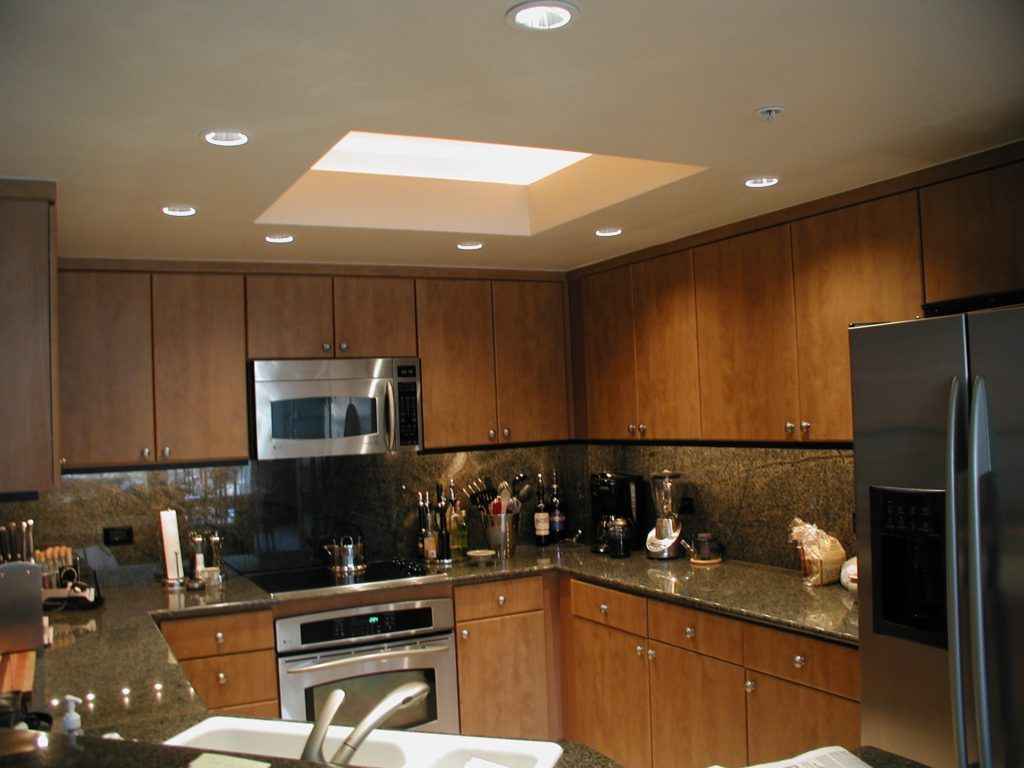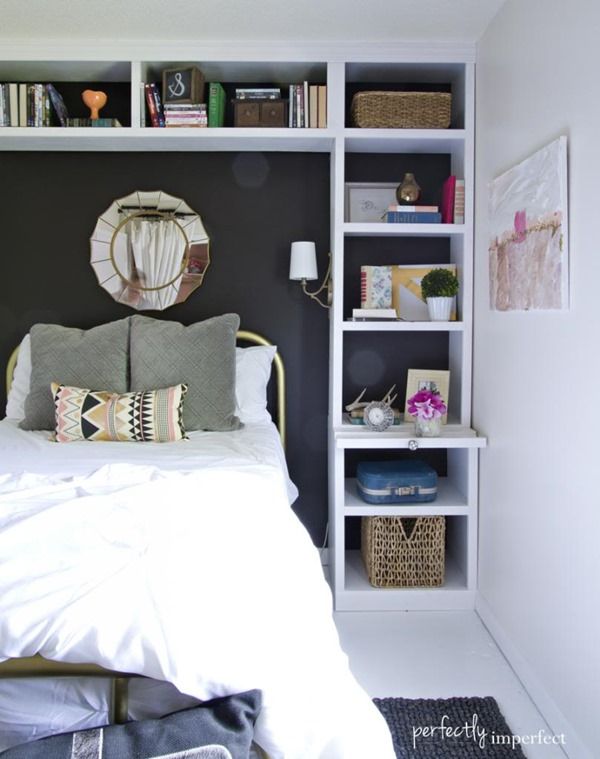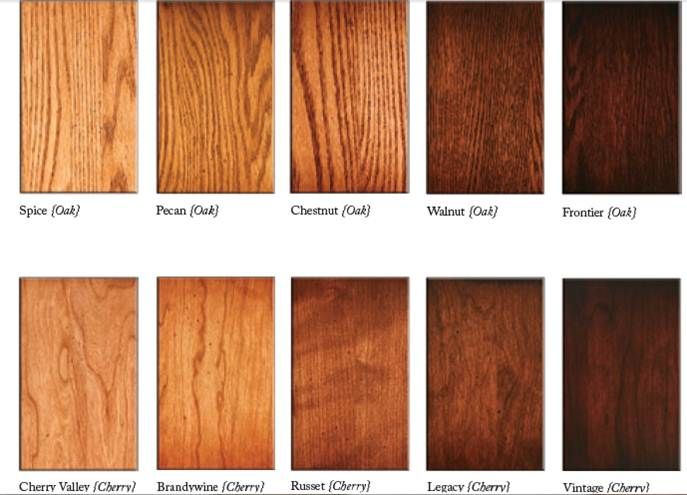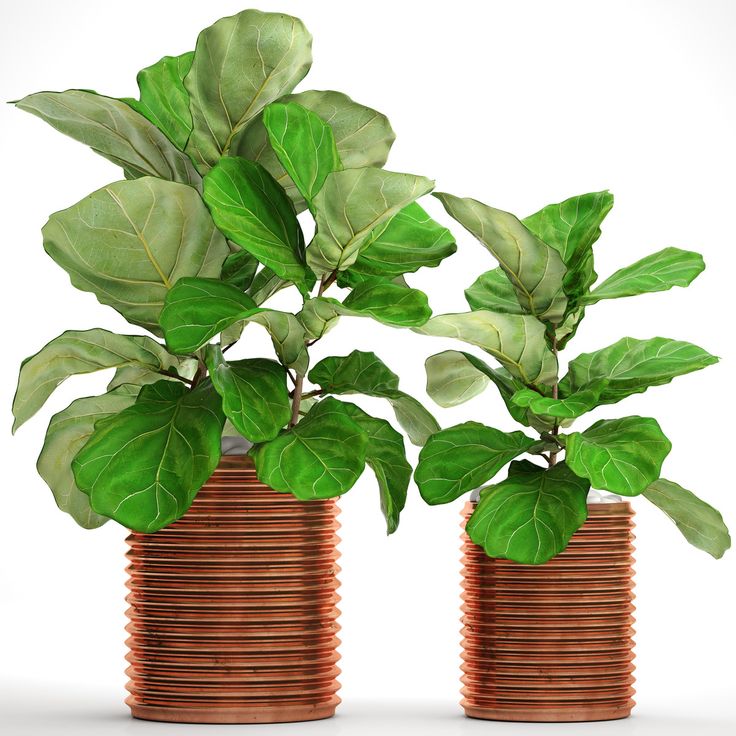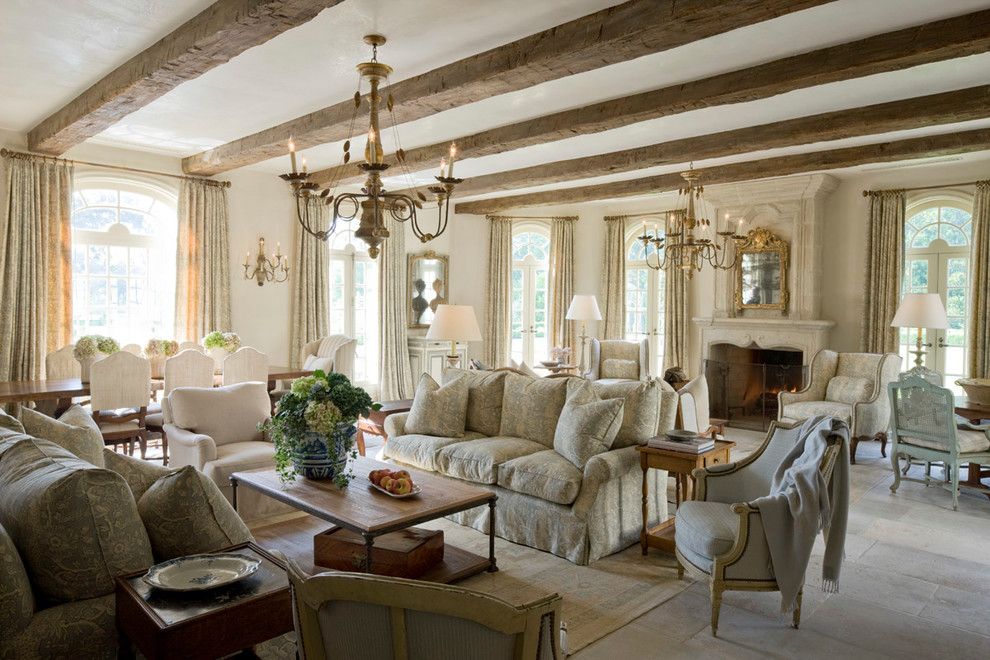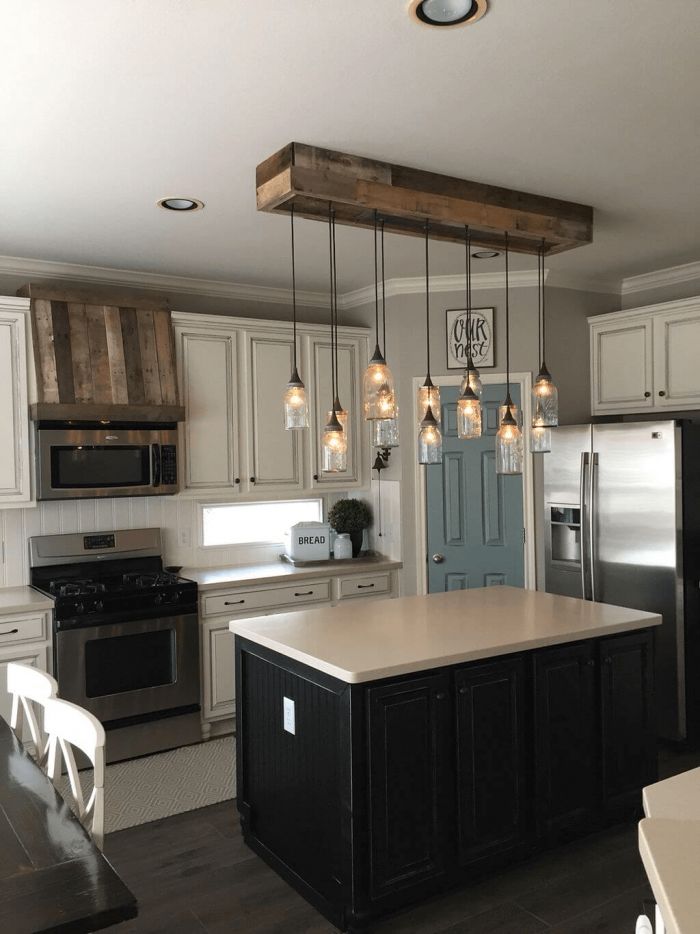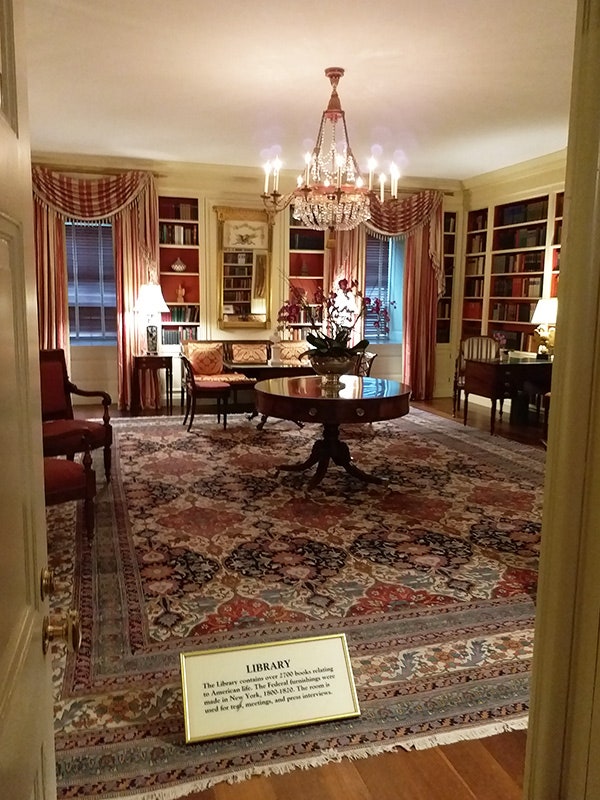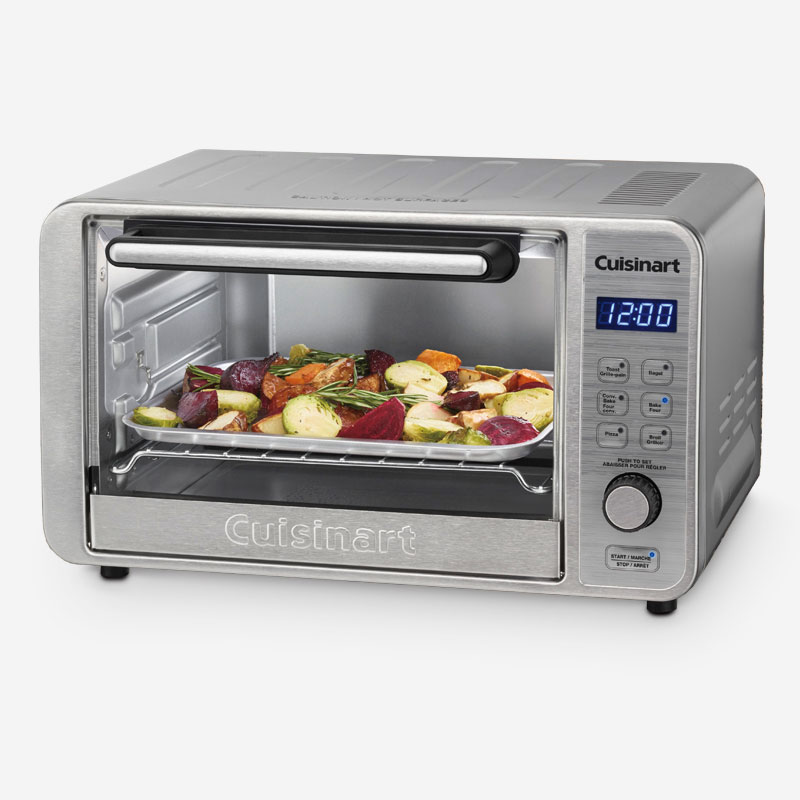Kitchen ceiling lighting layout
Lighting Guide: 7 Golden Rules to Plan & Light Your Kitchen
Photo credit: Mélanie Elliott
Lighting is an essential factor in creating a relaxing atmosphere, making the kitchen the ultimate place to relax, enjoy a drink, prepare meals, do homework, play board games or simply take the time to read a good book.
During this isolation period, we are spending more time indoors (and spending more time surrounded by artificial light). It is therefore all the more important to ensure that the lighting in our homes has a positive effect on our stress level and our general well-being.
To help you optimize this aspect that often gets overlooked, we interviewed Maude Rondeau, president of Luminaire Authentik, to get her best tips for creating a cozy atmosphere in the kitchen.
The golden rules
Here are 7 golden rules that we always follow when designing lighting plans for our clients. To illustrate these rules, let’s take the example of this lighting plan which was recently created by our designer Bianca.
Always place lighting 12 inches in front of tall elevations. This will ensure adequate lighting inside your cabinets, while highlighting materials such as wood. Example: on this lighting plan, the fridge and the pantry located in the lower right corner represent high elevations.
Don’t forget to add lighting under your cabinets! Example: on this lighting plan, LED light strips have been installed under the cabinets to appropriately illuminate the work surfaces.
Always install lighting in the centre of the island. Example: on this lighting plan, we can see 3 lights above the island; the central light is located in the very centre of the island (both horizontally and vertically) and serves as a guide for the other two lights, which are placed at equal distance from this central light.

Watch out for joists! Make sure you know your ceilings before you start planning your lighting. Since it’s not possible to install recessed lights on joists, you will be able to adjust your plan accordingly.
Multiply the light sources. These four types of lighting should be favoured in the kitchen: ambient lighting, task lighting, accent lighting and decorative lighting. The addition of several light sources will meet these four needs while creating a soothing and inviting atmosphere.
Direct the lights towards the work areas (cooking area, cleaning area and food preparation area). Example: on this lighting plan, there are suspended lights above the island (food preparation area and cleaning area), an illuminated hood (cooking area), as well as LED light strips for the other work areas. In the walk-in pantry, LED light strips will illuminate the contents of the shelves.
When there are cabinets above the counter, align the lighting with the edge of the counter.
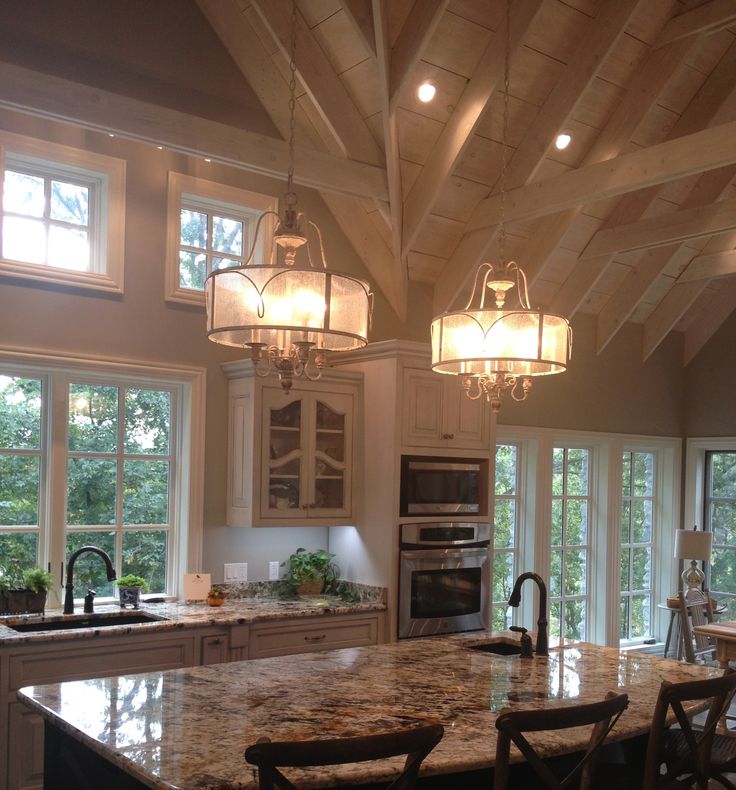 If there are no cabinets, it is possible to align the lighting in the centre of the counter. Example: on this lighting plan, the lighting in the pantry is aligned with the edge of the counter.
If there are no cabinets, it is possible to align the lighting in the centre of the counter. Example: on this lighting plan, the lighting in the pantry is aligned with the edge of the counter.
The main types of lighting to use in the kitchen
Before you begin, we suggest that you define your needs by dividing your lighting planning into four sections: ambient lighting, task lighting, accent lighting, and decorative lighting.
Ambient
Let’s start with an essential: ambient lighting!
“We often suggest mixing functionality and design to create a temperature, choosing recessed lights for direct lighting and linear models with glass balls for more diffused lighting. Above the island, suspensions will provide warmer lighting in the kitchen,” says Maude.
Mixing lights is key. “Using only recessed lights would make the atmosphere cold and clinical, but recessed lights work well with other types of lights. So always think about the function while aiming to create an atmosphere,” adds Maude.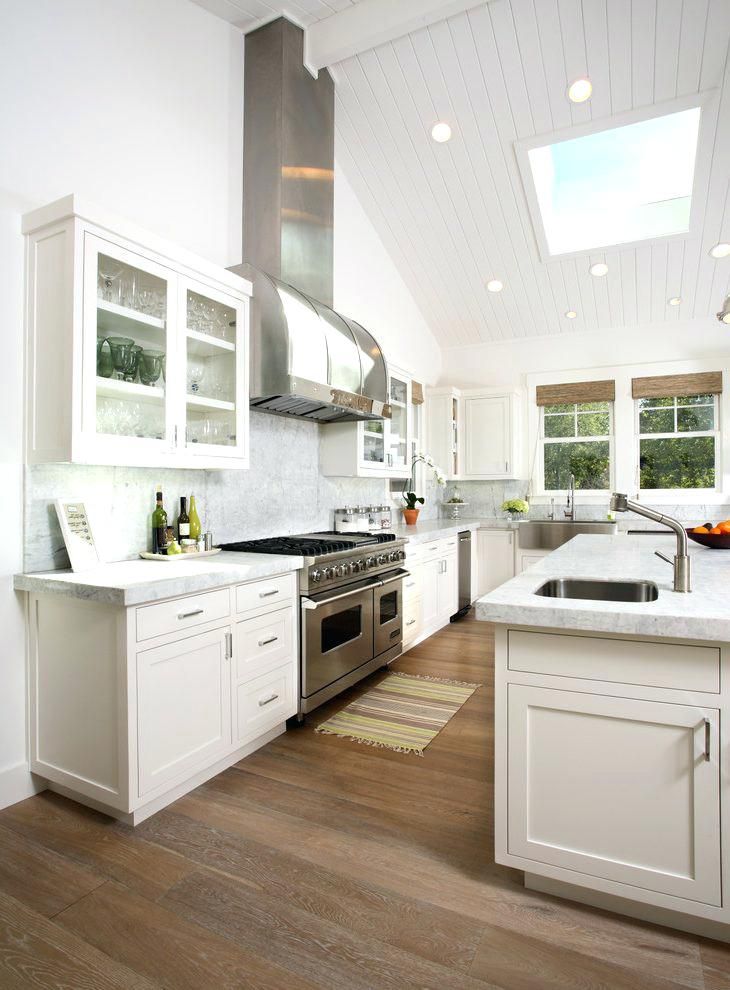
In order to create an atmosphere in the kitchen, we suggest that you treat this room as if it were part of the living room. It will then integrate harmoniously with the other rooms in the house.
Task
Task lighting refers to the lighting in the cooking area, the cleaning area and the food preparation area. Precise lighting directed towards these areas will allow you to work safely while reducing eye strain. LED light strips under the cupboards, recessed lights in the pantry or above the island and hanging lights are all great options to provide adequate lighting for these areas.
When planning your lighting, make sure that the light that will illuminate your worktop will not be positioned behind you. Instead, opt for ceiling lighting; thus, you will avoid creating shadows in front of you.
Task lighting: our favourite lamp
Our founder Brigitte fell in love with the Tolomeo work lamps by Artemide, which she hangs on her counter to light up her work plan when she’s cooking—and to create a relaxing atmosphere when she’s not!
Accent
Project by Cuisines Steam including illuminated niches that display the owners’ travel memories.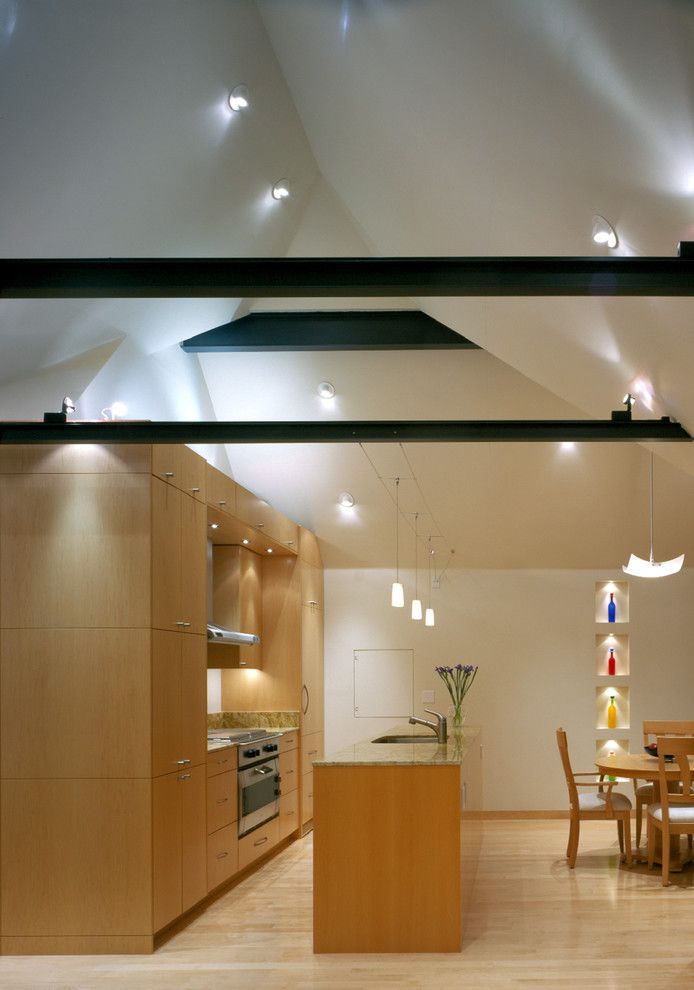 Photo credit: Mélanie Elliott.
Photo credit: Mélanie Elliott.
Accent lighting is commonly used to direct attention to certain objects, such as works of art and collectibles. To do this, we suggest that you opt for wall lights or track lighting. In addition, if you have a glass cupboard, you can add a light inside to illuminate the contents.
This type of lighting can also be used to highlight certain features of the space. For example, our designers often use lighting to enhance certain materials, such as solid wood, or to add depth and dimension to kitchen niches.
Decorative
Project by Cuisines Steam in collaboration with Alexandre Lafleur, featuring a Luminaire Authentik light fixture. Photo credit: Mélanie Elliott.
Decorative lighting is often used in Steam kitchens to complete the look of the room. To choose the right decorative lighting, be sure to select a light that complements your space, but does not dominate it.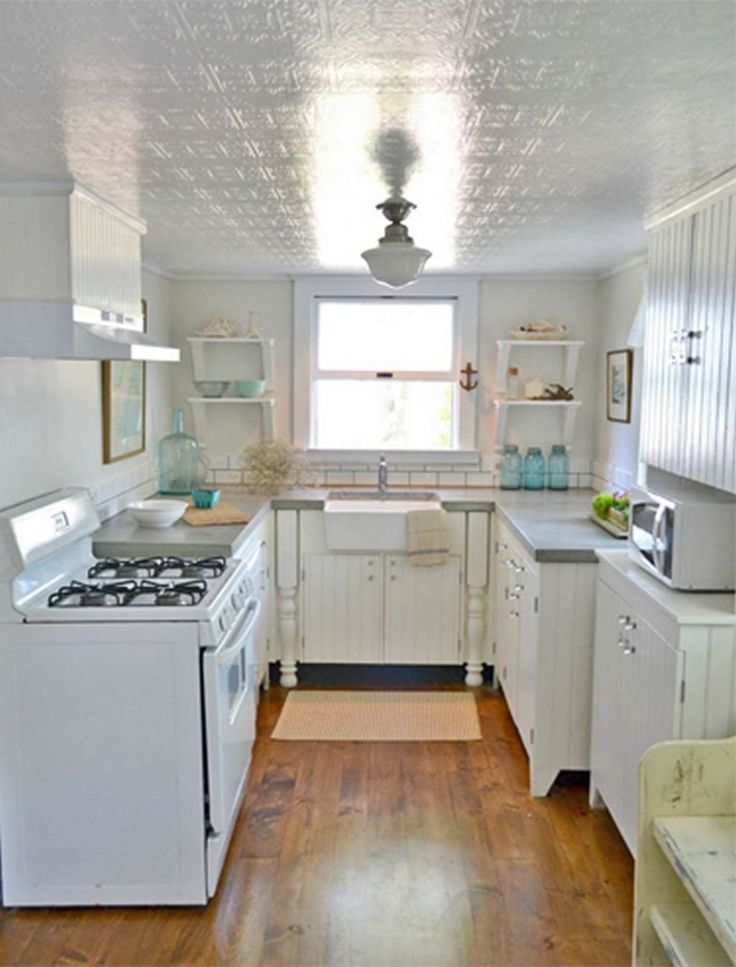
When it comes to kitchen island lighting, Maude always recommends using an odd number of pendant lights. As a general rule, it is also suggested to install the lights 30 to 36 inches above a counter (distance between the top of the counter and the base of the light).
Two elements that are often forgotten according to Maude
Dimmers
Opt for dimmable lights to vary the light intensity depending on the occasion—for example, by opting for a soft light to create a relaxing and cozy atmosphere during gatherings with family and friends, or by adjusting the brightness according to the seasons.
Kelvin colour temperature
The Kelvin scale is an essential tool for choosing a colour temperature. A lower Kelvin degree = warmer light, while a higher Kelvin degree = cooler light. For a warm atmosphere, we suggest that you opt for a Kelvin degree between 2500 K and 3000 K.
Locally-made lighting: our 5 favourites
Are you currently looking for lighting for your space? Here are 4 Quebec brands to discover!
Luminaire Authentik
Luminaire Authentik is a company from West Brome that designs and manufactures Scandinavian-inspired fixtures. From its workshop, the company has worked on impressive projects for the Montreal Museum of Fine Arts, Ubisoft, WeWork and several hotels such as the Fairmont The Queen Elizabeth. Click here to visit their online store!
From its workshop, the company has worked on impressive projects for the Montreal Museum of Fine Arts, Ubisoft, WeWork and several hotels such as the Fairmont The Queen Elizabeth. Click here to visit their online store!
HAMSTER
HAMSTER designs and manufactures light fixtures in Villeray—and even offers a consultation service for your custom projects! Click here to discover the lights from their classic collection, available in several heights and in two colours (brass and matte black).
Photo credit: HAMSTER
Lambert & Fils
Lambert & Fils is a Montreal-based design studio specializing in handcrafted lamps and lighting, drawing inspiration from various elements: linear suspensions (Mile collection), circles and spheres (Laurent collection), curved lines (Beaubien collection), geometric compositions combined with the rich texture of brass (Dot collection) and glass panels (Sainte Atelier collection).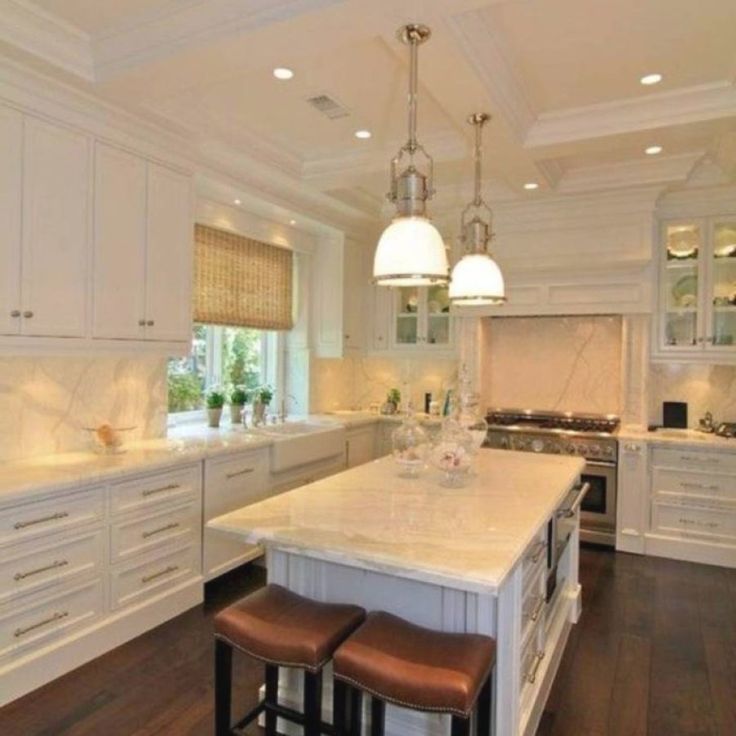
Photo credit: Lambert & Fils
D’Armes
D’Armes designs unique high-quality lighting under 3 collections: the Cé series, composed of elegant fringed light fixtures, the Ra series, composed of reinvented neon lights, and the Hartau series, composed of classic light fixtures that surprise with their lines and their details.
Photo credit: D’Armes
TipsFrédérique Michelkitchen, lighting, localComment
0 LikesTips for designing a kitchen lighting layout |
Homes & Gardens is supported by its audience. When you purchase through links on our site, we may earn an affiliate commission. Here’s why you can trust us.
(Image credit: Caesarstone)
It is important to start thinking about how to plan kitchen lighting as early as possible in your kitchen design process.
The kitchen is the ultimate multi-tasking room in the home – a space to prepare food, entertain and (these days) work from home. The right kitchen lighting layout should allow the kitchen to flow seamlessly through each of these roles.
Good kitchen lighting ideas will offer different levels of brightness and be able to alter the mood and feel of the room. Lighting schemes can make a space feel larger or cozier with a combination of well-placed task and mood lighting.
'Lighting is an extremely important element of a kitchen's design,' explains Daniel Bowler, Director of Eggersmann UK . 'Yet it is often something that gets left until last. Including it as part of the early planning process if you are redesigning your kitchen will give a much more effective result.'
How to plan kitchen lighting
When thinking about how to plan a kitchen lighting scheme, you need to ensure it includes three types of lighting: task, accent and ambient.
Task lighting is the brightest and used to illuminate work areas, while ambient is softer.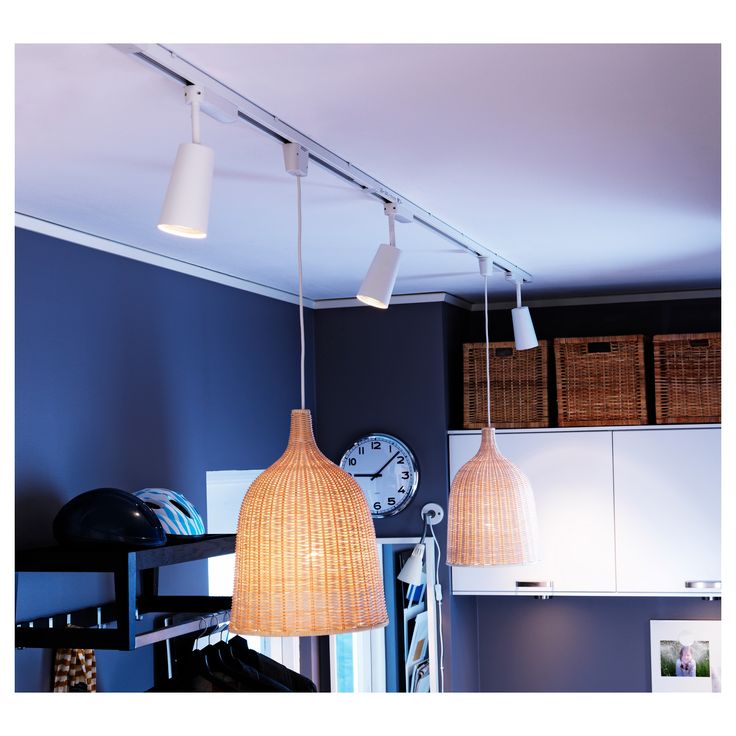 Accent lighting, also sometimes called feature lighting, refers to the visual interest it adds to a kitchen, either through the fitting itself or the light it emits.
Accent lighting, also sometimes called feature lighting, refers to the visual interest it adds to a kitchen, either through the fitting itself or the light it emits.
(Image credit: Harvey Jones)
When choosing kitchen lighting and planning your layout, always start with task lighting.
'The first thing to consider is where in the kitchen needs to be particularly well lit,' explains Daniel Bowler. Most working areas, such as countertops and the cooker, will need to be fitted with functional task lighting.
After establishing this foundation, think about how you want the kitchen to look when you are not cooking. When planning your ambient lighting consider how much natural light there is in the kitchen and the mood you want to create. For multi-functional kitchens, it is worth considering dimmer switches to alter the brightness.
Finally, add another layer of visual interest to your lighting scheme with accent lighting. Accent lighting guides the eye, so consider any areas of the kitchen decor you would like to highlight.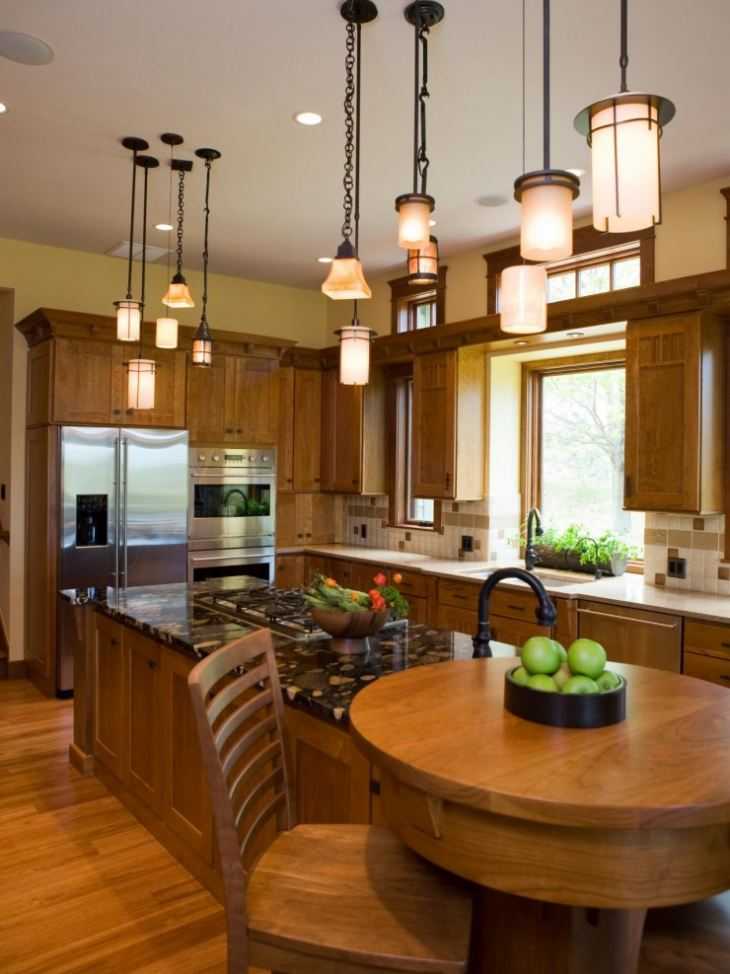
(Image credit: Life Kitchens)
What type of lighting is best for kitchens?
Task lighting is an essential part of any kitchen, commonly integrated into wall cabinets or above working areas. There are lots of variations of task lighting to choose from.
Small, compact fluorescent lighting can be slipped into the recess in the bottom of an overhead unit.
LED lighting can be fitted under cabinets or in drawers, pantry units and other kitchen storage solutions. Ceiling mounted lights with directional spots or pendant lights will also work as long as they create a focused beam of light.
(Image credit: Harvey Jones)
Ambient lighting needs to give off a soft, diffused glow. This can be achieved with a ceiling-mounted lighting fixture, recessed lights, kitchen wall lighting or washers.
Recessed lights, flush mounts and semi-flush mount ceiling lights are useful when thinking of small kitchen ideas because they don't take up too much room.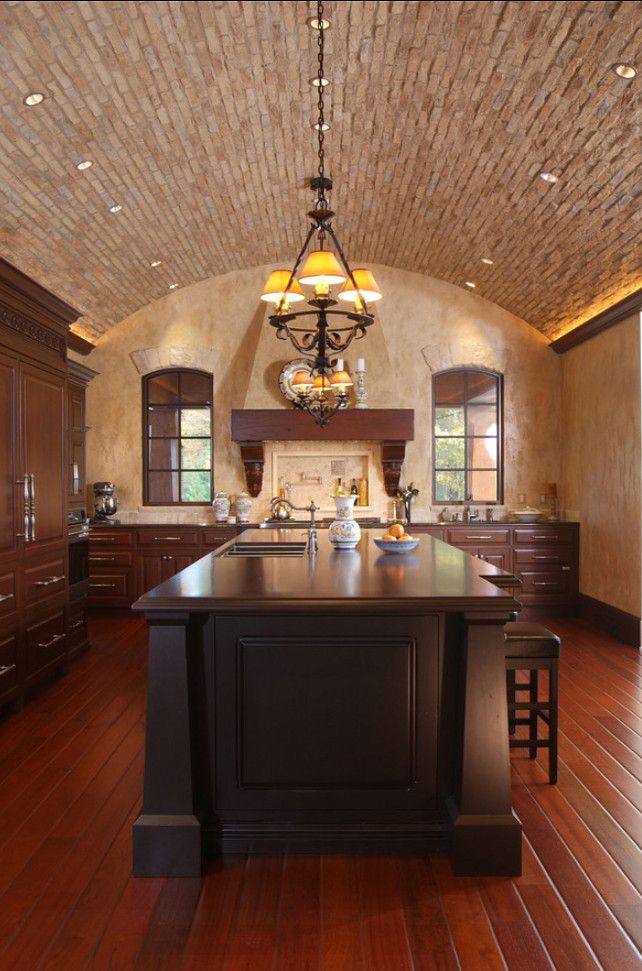 High ceilings will benefit from uplighters on top of the kitchen cabinets to enhance the general light.
High ceilings will benefit from uplighters on top of the kitchen cabinets to enhance the general light.
'To create a warm atmosphere in the evening, choose lights that can be transitioned from cool to warm,' recommends Graeme Smith, Head of Retail and Commercial Design at Life Kitchens . 'Offering versatility, the adjustable tone means that it can be cool when cooking and warm when dining or entertaining.'
(Image credit: Future)
Accent lighting can come in many different forms. It can refer to a statement floor lamp used to illuminate a corner of the kitchen, or LEDs built into the plinth of a central island to make it appear as if it is floating. It can also be used as backlighting to add to the aesthetic of the kitchen.
(Image credit: Davide Lovatti/Future PLC)
How do you calculate kitchen lighting?
To calculate how much light your kitchen needs, you need to talk in terms of lumens. Lumens refer to brightness levels.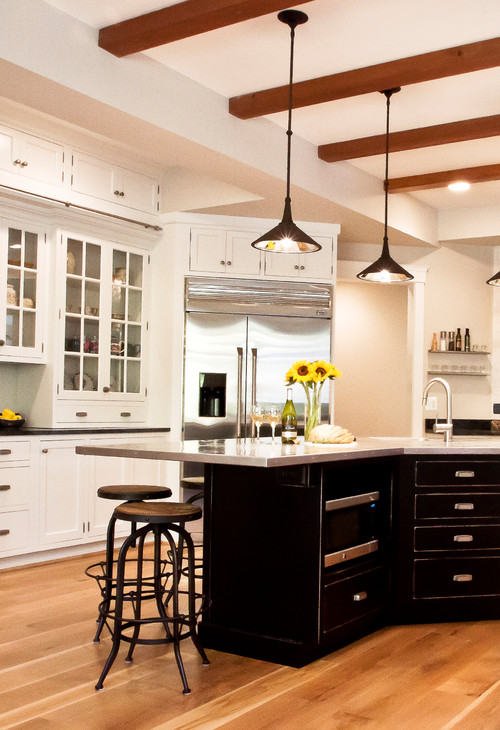 How bright your kitchen lights need to be will depend on what you are using your kitchen for and how many lights you have.
How bright your kitchen lights need to be will depend on what you are using your kitchen for and how many lights you have.
To work this out, multiply the kitchen floor area in square feet by the foot-candle (light intensity) needed. So if your kitchen is 100 square feet, which will need between 10 and 20 foot-candles, you will need 1,000 to 2,000 lumens. Bulbs deliver a certain number of lumens, so you can work out how many bulbs you need by dividing the number of lumens by the number of lumens each bulb delivers.
Happily, a good lighting designer – or experienced interior designer or builder – will be able to advise you on what you need.
'If you have one light, then you need it to be as bright as possible, but again, dimmable,' explains Niki Wright, lighting design expert and founder of Lights & Lamps . 'If you plan your kitchen with various forms of lighting all around, it will be bright enough to work in.'
(Image credit: Life Kitchens)
Where should kitchen lights be placed?
Think about the purpose the light is serving when choosing where to position it in a kitchen.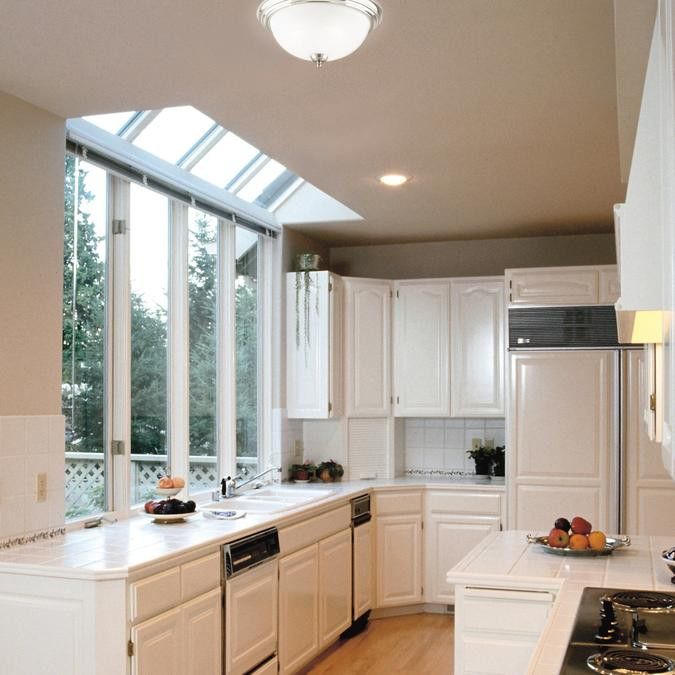
Task lighting needs to cast light over a countertop, unimpeded. This means that it needs to be positioned to hit the back/center part of the countertop, so that when you are bending or leaning forwards over it – perhaps chopping, mixing or stirring – your shadow is not cast over what you are prepping, but just in front of it, meaning that it is illuminated perfectly.
'Make sure you position spotlights or pendants directly above key areas to ensure the light isn't blocked when you stand at the sink, hob or worktop,' explains Melissa Klink, Head of Design at Harvey Jones .
Accent lighting should be installed around any decor or architectural details you'd like to accentuate. Position the light one to two inches from the back of a shelf to create a backlit effect.
Where you position ambient lighting will depend on the light fitting you have chosen. Flush or semi-flush fittings will usually sit over the kitchen island, or in the center of the ceiling if you don't have one.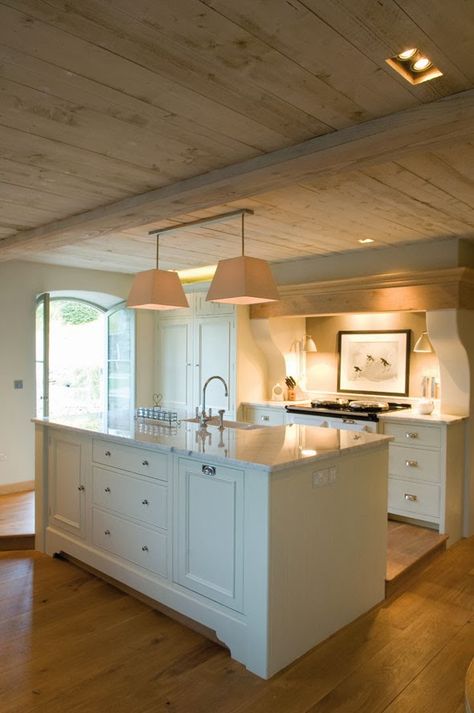
However, recessed lights need to be spaced out across the ceiling and set a few inches back from the front edge of countertops to avoid casting a shadow.
(Image credit: Davide Lovatti/Future PLC)
How should I light a kitchen island?
A row of matching statement pendants are a clever way of lighting your kitchen island. They create an eye-catching feature that will also provide practical task lighting.
However, Niki Wright suggests getting more creative with your kitchen island ideas. 'Think about what a kitchen island is used for. Is it purely prep and cooking or is it used as a dining and social space?' he asks.
'A combination of dimmable recessed downlights alongside a more decorative pendant or even a chandelier can really change the whole feeling of the area.'
(Image credit: Davide Lovatti/Future PLC)
Are LED lights good for a kitchen?
LED lights are a perfect modern kitchen lighting option – more eco-friendly than other types of lighting, they give off little heat and can create a natural daylight feel.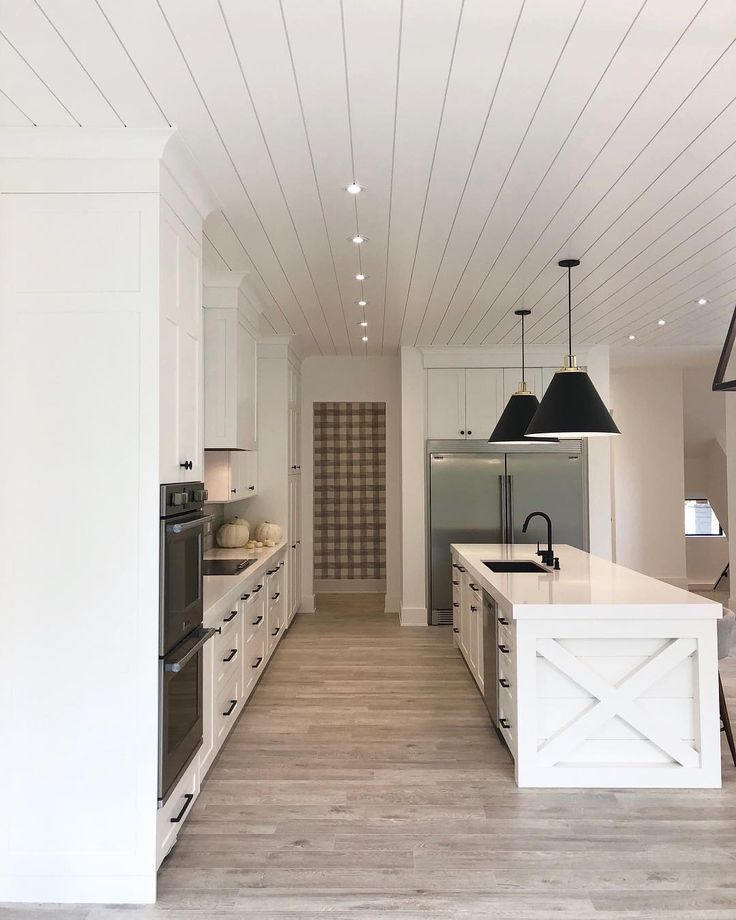
Cool white LED lights are best suited for the kitchen, whether you are using them for task, accent or ambient lighting. To help you pick the correct color, check the Kelvins – a bright or cool white will usually be 4,100 Kelvins.
'In a kitchen, you do not really want to go below 3,000 Kelvins as the light becomes too yellow,' explains Niki. 'But make it dimmable and you can create the right ambience for when the cooking turns to eating.'
Rebecca is the News Editor on Homes and Gardens. She has been working as a homes and interiors journalist for over four years. She first discovered her love of interiors while interning at Harper's Bazaar and Town & Country during my Masters in Magazine Journalism at City, University of London. After graduating she started out as a feature writer for Women's Weekly magazines, before shifting over to online journalism and joining the Ideal Home digital team covering news and features. She is passionate about shopping for well-crafted home decor and sourcing second-hand antique furniture where possible.
Lighting in the kitchen and in the kitchen-living room: lighting design rules - INMYROOM
Tips
What lighting scenarios should be in the room, what color temperature affects, why LED lamps are better than conventional ones - everything you need to know about lighting planning in the kitchen
The biggest mistake you can make when decorating a kitchen is to have only one light source. We tell you why you can’t do this, and give 6 practical tips for organizing lighting.
General advice on lighting design
1. Plan the location of the fixtures in advance: it's too late in the midst of repairs. The most optimal thing is to decide on the number and location of fixtures when you have outlined the main functional areas.
2. Sockets, switches, lights, wires Install at least 60 centimeters from sinks and water lines.
3. Use more than one light source. Be sure to provide lighting for the work surface. If there is a dining area, the ideal option is a lamp above the dining group or a sconce for softer lighting. Decorative light and lighting of wall cabinets will be useful.
If there is a dining area, the ideal option is a lamp above the dining group or a sconce for softer lighting. Decorative light and lighting of wall cabinets will be useful.
4. Adjust the space with lighting. Does the room have architectural flaws? To adjust the geometry of a narrow kitchen, place fixtures along one wall. Lamps located along the middle line of the ceiling, on the contrary, visually "stretch" the room.
Wall sconces with upward light will visually lift a low ceiling. But for a very high ceiling, pick up a massive chandelier.
5. Adjust the color temperature of the light. Modern LED luminaires provide light in a variety of colors and shades. Keep in mind that it is better to cook with as much natural light as possible - choose a cooler shade of lamps for the work area. But the appetite is promoted by warm and soft light.
6. Don't forget about savings. Use LED lamps: they reduce energy consumption by up to 90% and their service life is up to 15 years.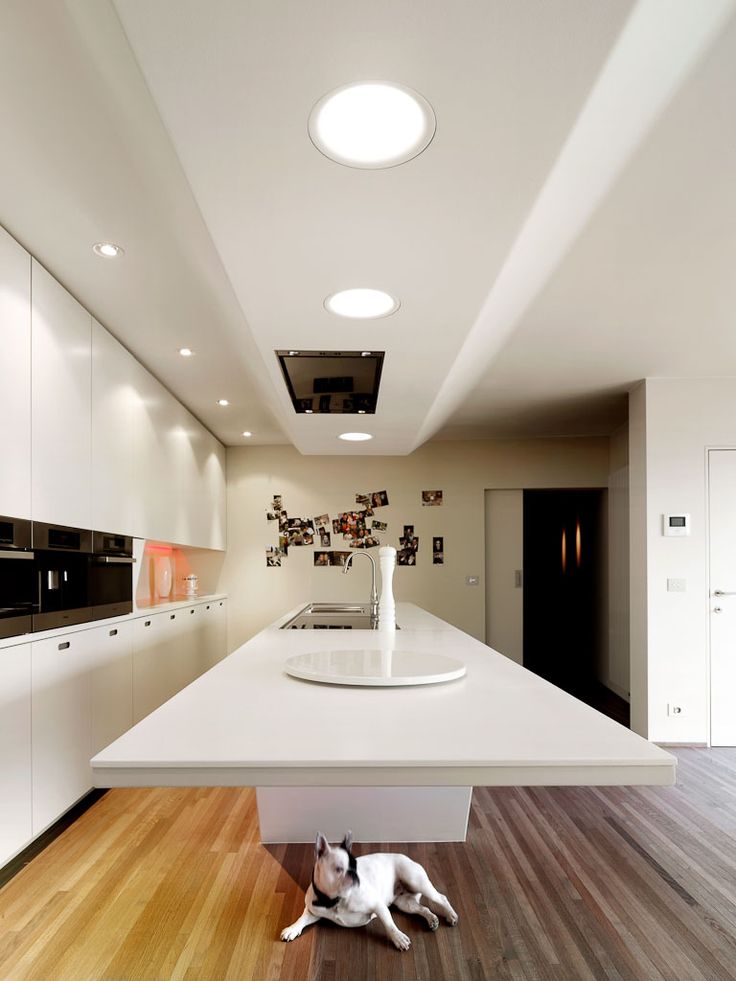 And dimmers will help to achieve the desired level of illumination and reduce energy costs.
And dimmers will help to achieve the desired level of illumination and reduce energy costs.
Kitchen Lighting Tips + Infographics
1. Place recessed ceiling spots at least 30-40 cm apart. From the corner of the wall to the lighting fixture, you must leave at least 20 cm. Experts recommend installing a lamp of 20 W per 1 square meter of ceiling. Draw a diagram of the location of the fixtures in advance and indicate the distance to the walls.
2. Spotlights built into the top cornice of kitchen cabinets or built into the bottom panel are essential for comfortable work. If there are open shelves on the wall instead of cabinets, use pendant lights. The optimal distance between the lower edge of the ceiling and the tabletop is 70-87 cm.
3. Hanging lamps with a long cord should not hang too low - it is easy to hit them with your head. If there is one ceiling lamp above the round table, the lower edge of the lamp should be in the range of 70–90 cm above the tabletop.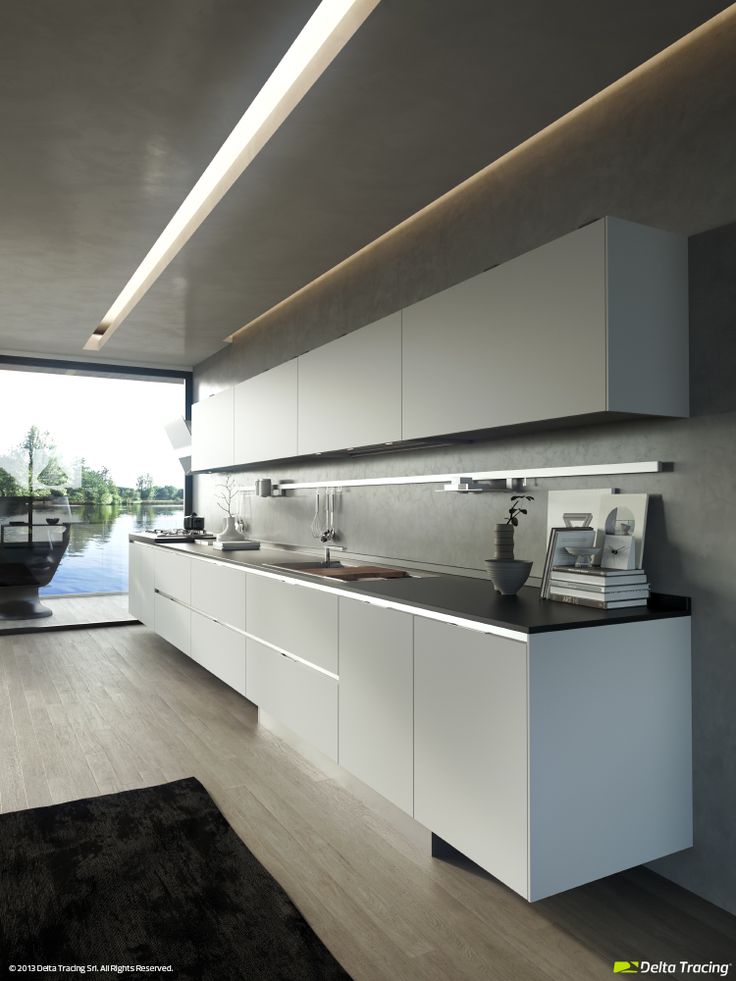 The optimal diameter of the chandelier is about half the width of the table.
The optimal diameter of the chandelier is about half the width of the table.
Above a long rectangular table, hang several lamps - stand back from the edges of the table 30 cm and place them at an equal distance from each other.
4. Group of pendant lamps - just what you need to illuminate the kitchen island. The distance between the lower part of the lamp and the tabletop is at least 65–70 cm: the light from hanging lamps should not hit your eyes.
Keep in mind that the distance between the lamps in the kitchen above the table should not be less than 30-40 cm.
If you have a kitchen-living room: 4 lighting rules
1. The main thing is functional zoning. Lights can literally turn different zones on and off. A central chandelier in the living area and spotlights in the kitchen are a great option. Do not forget also about the seating area: if you want to read in an armchair, a floor lamp with directional light will come in handy.
2. Hanging lamps above the bar counter - delicately zone the space. When the kitchen light is off, they will create a more intimate space in the living room - nothing will distract you from relaxing.
3. A must-have is a beautiful chandelier above the dining table. It will create the right mood: a solemn atmosphere when receiving guests or a romantic one for a dinner for two. Pay attention to the lamps, the height of which can be changed with one movement of the hand - this is convenient.
4. Decorative light: table lamps, sconces, floor lamp are responsible for a relaxed atmosphere and emphasize the decor. It is easy to highlight paintings, vases, dishes with the help of directional light fixtures: use built-in, wall, ceiling models.
Lighting trends: what the pros say
Are standard lamps boring and you want something more interesting? Lighting designer Polina Gubonina talks about current trends in lighting.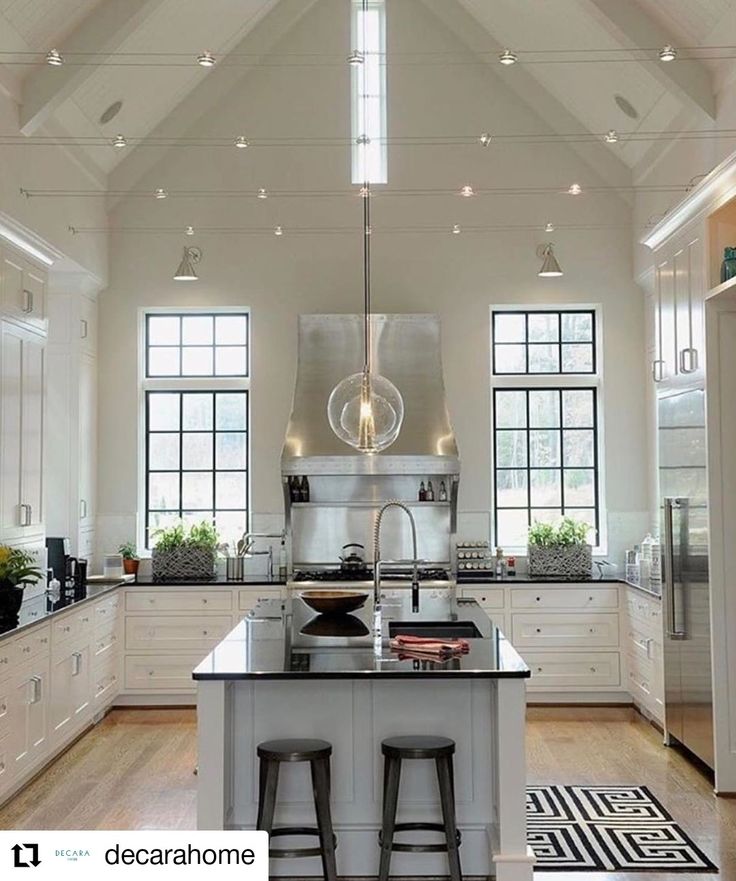
POLINA GUBONINA
LIGHTING DESIGNER
Leading lighting designer at Philips Lighting in Russia, a graduate of Moscow State Technical University im. Bauman.
1. To highlight the dining table, you can use not only a pendant lamp, but also a floor lamp installed next to it on a curved tripod, a table lamp with a diffusing shade or an accent spotlight mounted on the wall.
2. Use the LED strip to illuminate the glass table for contour lighting - the self-luminous effect is guaranteed. Position the tape inside cabinets with glass fronts for luminous stained-glass windows that create the effect of additional windows.
3. Place the LED strip inside shelves, under cabinets or along walls: all these ideas can be realized with minimal effort and without building dust.
Kitchen lighting with stretch ceiling
One of the most important conditions for aesthetic and high-quality installation of a stretch ceiling in a hall or kitchen is the right choice of lighting elements. Of course, you can completely entrust the lighting in the kitchen with a stretch ceiling to the installers of the ceiling itself, but there is no guarantee that they are well versed in this matter and will not want to install low-quality or undemanded types of fixtures.
Of course, you can completely entrust the lighting in the kitchen with a stretch ceiling to the installers of the ceiling itself, but there is no guarantee that they are well versed in this matter and will not want to install low-quality or undemanded types of fixtures.
Contents:
- Basic rules for the placement of luminaires
- Placement of luminaires in the kitchen
- Chandelier
- Types of ceiling lights for a stretch ceiling in the kitchen
- Which option is better to choose
- Housing G53
- Conclusion
- Video: installation of lights in a stretch ceiling
It makes no sense to turn to expensive designer services to solve this issue , an option may be to independently study the necessary information and make your own decision without imposing someone else's opinion.
The question of buying will also not be considered - there are a large number of online stores that offer a wide range of products - there should not be any problems here.
Basic rules for placing luminaires
In order to obtain high-quality lighting for a small kitchen, you should place the luminaires safely, functionally and aesthetically, observing the following rules:
- The distance from the spotlights to the wall should be at least 20 cm.
- The usual placement of a chandelier is in the center of the ceiling or in the middle of a separated zone, if stretch ceilings with lamps have several levels.
- when installing spotlights in a living room with stretch ceilings or a kitchen, their optimal number is calculated based on the lighting area of one lamp of 1.5 sq.m.
- all PVC ceilings have a vulnerable seam, luminaires should be placed no closer than 15 cm from it.
- If the luminaires for stretch ceilings in the kitchen are located symmetrically, it is necessary to observe the same distance of their placement from each other and from the walls.
- PVC film deforms at temperatures above 55 C, so recessed fixtures have power limitations: halogen up to 35 W.
 , incandescent lamps up to 40 W.
, incandescent lamps up to 40 W. - For installation in a stretch ceiling, a mounting ring is glued, the luminaire to be installed must have a side that will cover it.
- The heating temperature of the luminaire body must not exceed 60 C.
- Direct light from incandescent lamps can have a negative effect on the structure of the ceiling, so it is recommended to install frosted views.
- Installation of a large number of fixtures (20 or more) should be made from different power sources, this will reduce power losses.
Placement of lamps in the kitchen
There are more than a dozen schemes for placing lamps in the kitchen. The most commonly used option with spotlights is their location in the stretch ceiling above the work area in the form of a semicircle, straight line or angle, the illumination of a small dining table area is carried out by a chandelier located above it.
The work area is a particularly important place in the kitchen, so pay special attention to it when arranging
There are two types of spotlights used in a small kitchen: fixed and rotary. The latter allow, if necessary, to direct the light to the right place.
The latter allow, if necessary, to direct the light to the right place.
One way of lighting is to insert one or more panels of translucent material with a standard size of 60 by 60 cm into the stretch ceiling, while the light source is attached to the floor slab behind the panel.
Chandelier
The kitchen is a small room, so lighting a small area does not allow the use of large and bulky chandeliers, they do not fit into the design and are impractical.
Depending on the design of the kitchen, several types of chandeliers with their own unique style can be used.
- Classic. The usual execution is crystal, most often used in the living room kitchen.
- Modern. Performed in a fabric version, the edging contrasts with the general background of the ceiling.
- Tiffany chandeliers. They resemble a scattering of amber of various colors: brown, gold, beige.
- Hi-tech. They have strict geometry and restrained tones, suitable for rooms with a small amount of furniture.
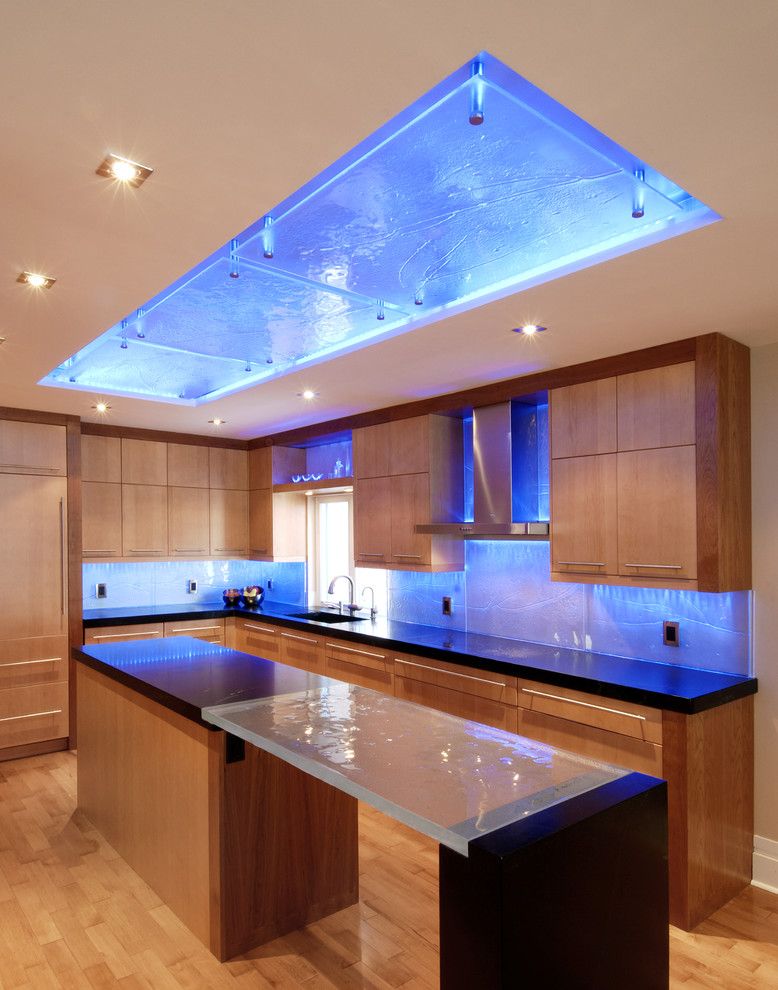
Types of ceiling lights for stretch ceilings in the kitchen
Lights for stretch ceilings in the kitchen should not only have an aesthetic appearance, but also be safe and economical. Lighting in the kitchen, in addition to proper placement, should include a rational selection of lamps, otherwise errors will lead to sagging, deformation or damage to the ceiling. For installation in a stretch ceiling, several types of luminaires are used, which have a different physical principle of operation.
Incandescent lamps
This type of lamp is short-lived and is chosen as an exclusively budget option.
Budget option, currently obsolete type of lighting, the least suitable for work in stretch ceilings. They have a low luminous flux at high power, they get very hot. When used in stretch ceilings, their power should be no more than 45 W. It is more practical to choose a model with a mirror reflector.
Halogen lamps
High brightness alternative to budget halogen lamps
The main difference between halogen lamps and conventional incandescent lamps is the bulb material and the type of inert gas.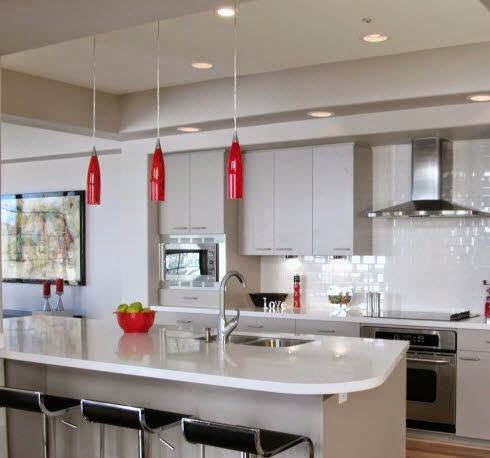
They are made in the form of a glass bulb made of high-temperature quartz glass with a transparent or matte surface, with a tungsten filament located in the middle and filled with halogen. When an electric current flows, the filament heats up to 2500 C and a glow is created.
Features
- Low cost.
- High power, 20% more economical than incandescent lamps.
- Strong heating during operation, inherent in incandescent lamps.
- High brightness with a characteristic white light that some people don't always like.
- Quick start.
A structural disadvantage of halogen lamps when installing a stretch ceiling is that their reflectors let light into the ceiling and engineering elements hidden behind the film (air ducts, power wiring) can be seen.
Fluorescent lamps
Fluorescent lamps with good light output
Discharge lamps, the principle of which is to emit ultraviolet radiation from mercury vapor when an electric current is passed through them, and the inner layer of the phosphor coating of the lamp bulb begins to glow.
Features
- They are considered to be more durable lighting devices, unlike incandescent lamps, in the absence of sudden voltage drops in the network and limiting the number of inclusions.
When the fluorescent lamp is turned on, a special composition burns out and falls off, which ensures the stability of the discharge and protects the tungsten filament from overheating. In this case, the edges of the bulb darken and the service life of the discharge lamp is reduced.
- With the same power consumption, they have a light output 3 to 4 times greater than that of incandescent lamps.
- Do not heat up.
- They do not turn on immediately, they have a long start-up time, up to 30 seconds.
LED strip
LED strip is used as an alternative light source, mainly as a decorative element
Structurally, the strip is made in the form of a flexible strip, on which there is a board with tracks, resistors and LEDs in the form of separate segments.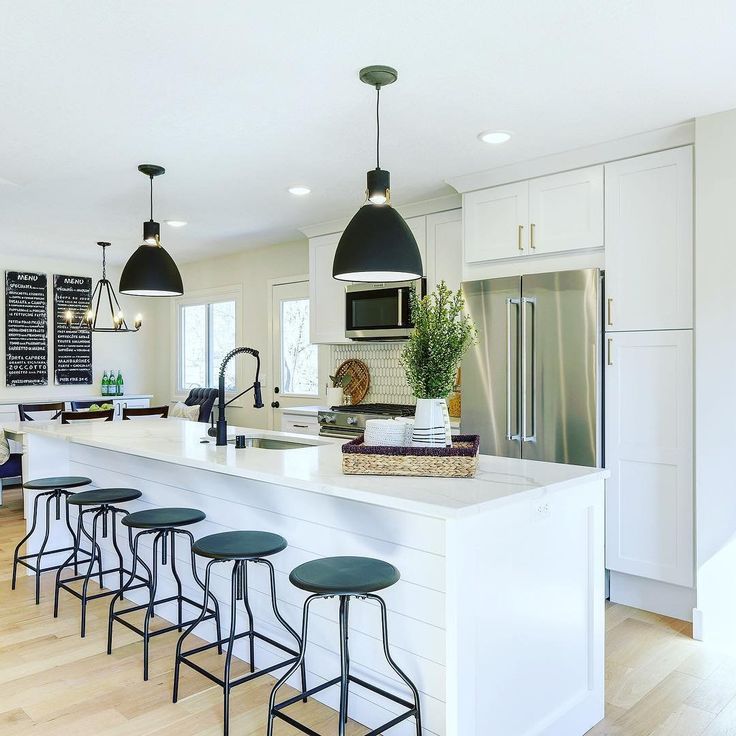 The tapes produced can have different colors of radiation (RGB LED), have a length of about 5 m, differ in the number of LEDs per 1 r.m. (from 30 to 120) and their type (SMD and DIP).
The tapes produced can have different colors of radiation (RGB LED), have a length of about 5 m, differ in the number of LEDs per 1 r.m. (from 30 to 120) and their type (SMD and DIP).
- High price.
- Long service life (approx. 50,000 hours).
- Easy to mount on self-adhesive foil, can be cut up to 10 mm. or increase without restrictions.
- Bright light (up to 2400 lm. per meter) with a wide spectrum of glow colors.
Two types of ribbons are available - monochrome with one color and universal RGB, the color gamut of which is electronically regulated - the colors are switched by the remote control.
- No heating.
- Have several types of protection against moisture, some modifications may be under water.
- Operates on 12 or 24 V DC and therefore requires a separate power supply.
- Have a wide operating temperature range from -40 to +80 C
- Power consumption depends on the number of LEDs per meter of tape, in super-bright SMD3014 with their number of 120 pcs.
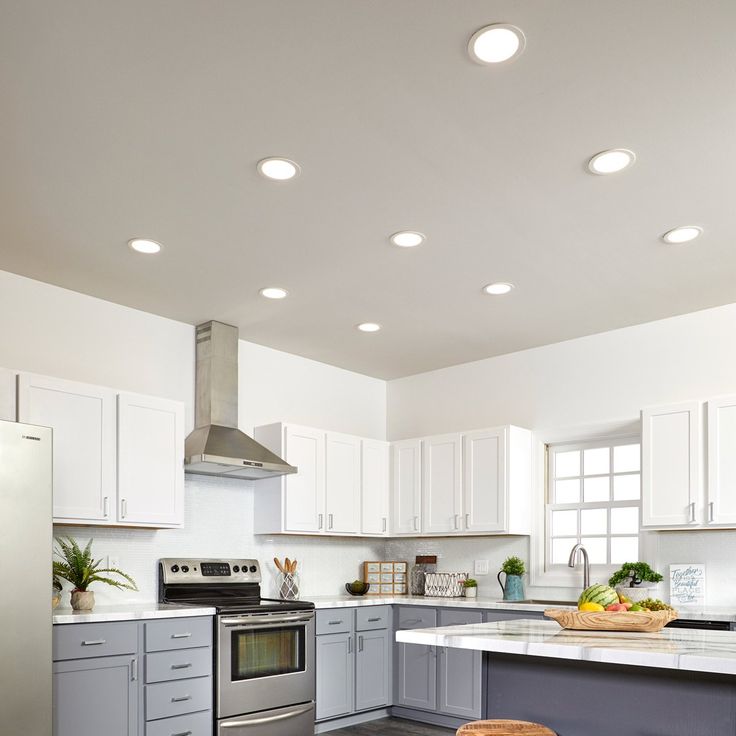 and a luminous flux of 1200 lm., it is 12 watts, which is equivalent to an incandescent lamp of 80 watts.
and a luminous flux of 1200 lm., it is 12 watts, which is equivalent to an incandescent lamp of 80 watts.
Idea!
Optical fiber is used as a complementary element to lighting devices to create various lighting effects such as "starry sky" or "flickering flames". The device of such effects is quite expensive, but the service life of the fiber is not limited.
LED luminaires
LED luminaires are the most efficient among their counterparts
Currently, stretch ceilings with LED luminaires are the most popular. Although they are considered the most expensive of all existing types, there are affordable models with all the advantages of expensive ones.
Features
- Shock and vibration resistant.
- Low flammability, does not get hot.
- High luminous efficiency, long life.
Which option is better to choose
The best option for spotlights is to use LEDs as working elements, they heat up less, give more intensive illumination and have a very long service life.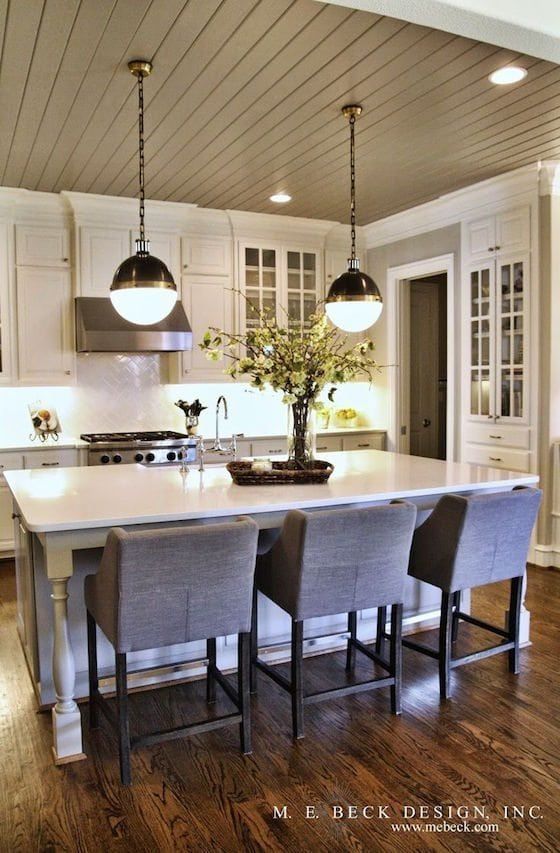
An important advantage of LEDs is their flat design in a number of fixtures.
Important!
Used kitchen stretch ceiling fixtures in the form of LED panels can have a total thickness of no more than 2 cm, which allows you to arrange a suspended ceiling with a minimum distance from the floor panel slab.
Halogen bulbs consume more electricity and have a shorter lifespan.
The main disadvantage of fluorescent lamps is their long switching on (may be 30 seconds), which creates great inconvenience and hinders their widespread use.
Illuminated stretch ceiling in the kitchen has high thermal sensitivity. With increased heat exposure, it melts and spots can form on it. Therefore, it is most rational to use lamps with a low heating temperature for its illumination. In this case, incandescent and halogen lamps will not be a very good option; fluorescent and LED elements are more suitable.
Housing G53
In the standard G5.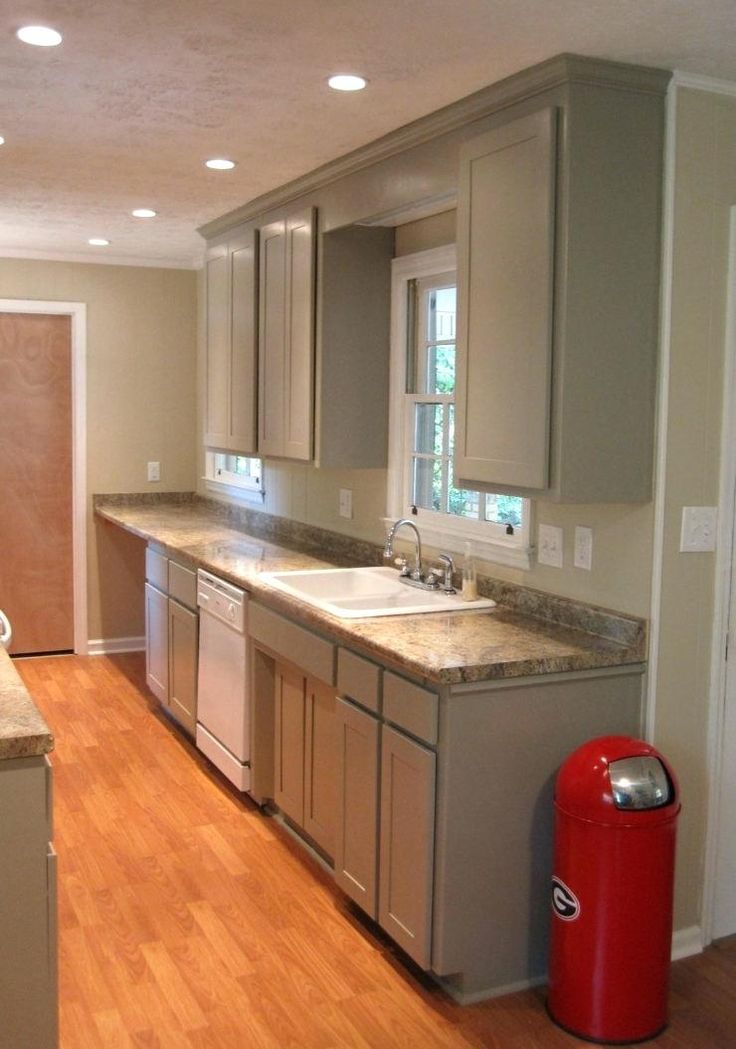 3 base luminaire, the lighting lamps were fixed with a clamping ring, while they were recessed into its housing and provided a sharp dispersion angle.
3 base luminaire, the lighting lamps were fixed with a clamping ring, while they were recessed into its housing and provided a sharp dispersion angle.
More functional housing models with GX53 luminaires have been developed. To work with them, the lamp has a constructive shape in the form of a flat washer with contact terminals of two protruding pins, which are simultaneously used when mounting in a cartridge.
Case example GX53
For installation, it is brought from below to the socket so that the pins fall into the grooves, and rotated - the outer surface of the fixed lamp protrudes 4 - 5 mm beyond the dimensions of the case, this allows you to illuminate the room at the widest angle.
In addition to increasing the angle of dispersion, the design of the housing allows you to increase the height of the ceiling due to a flatter design and extension of the lamp beyond the ceiling plane, provides convenient replacement of lighting elements.
When using LED lamps in these luminaires, it is necessary to check the presence of a cooling grill on the back wall in the form of a metal radiator, this increases the lamp life to at least 3 years.